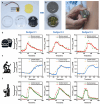Advances in Wearable Biosensors for Healthcare: Current Trends, Applications, and Future Perspectives
- PMID: 39590019
- PMCID: PMC11592256
- DOI: 10.3390/bios14110560
Advances in Wearable Biosensors for Healthcare: Current Trends, Applications, and Future Perspectives
Abstract
Wearable biosensors are a fast-evolving topic at the intersection of healthcare, technology, and personalized medicine. These sensors, which are frequently integrated into clothes and accessories or directly applied to the skin, provide continuous, real-time monitoring of physiological and biochemical parameters such as heart rate, glucose levels, and hydration status. Recent breakthroughs in downsizing, materials science, and wireless communication have greatly improved the functionality, comfort, and accessibility of wearable biosensors. This review examines the present status of wearable biosensor technology, with an emphasis on advances in sensor design, fabrication techniques, and data analysis algorithms. We analyze diverse applications in clinical diagnostics, chronic illness management, and fitness tracking, emphasizing their capacity to transform health monitoring and facilitate early disease diagnosis. Additionally, this review seeks to shed light on the future of wearable biosensors in healthcare and wellness by summarizing existing trends and new advancements.
Keywords: bioanalysis; lifestyle; personalized health management; telemedicine; wearable biosensor.
Conflict of interest statement
The authors declare no conflicts of interest.
Figures








References
-
- Zeng X., Peng R., Fan Z., Lin Y. Self-powered and wearable biosensors for healthcare. Mater. Today Energy. 2022;23:100900. doi: 10.1016/j.mtener.2021.100900. - DOI
Publication types
MeSH terms
LinkOut - more resources
Full Text Sources

